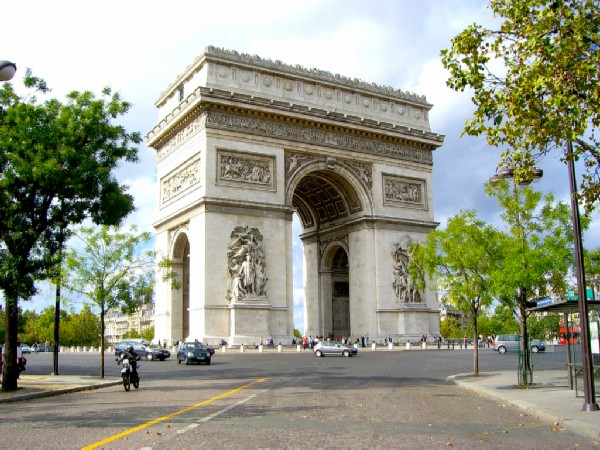Parisian Arc de Triomphe

The unrivaled Arc de Triomphe in France is a true work of art.
The Arc de Triomphe in Paris is the largest in the world. Every year this amazing place is visited by thousands of tourists from all over the world. It attracts with its grandeur, luxury, uniqueness.

Parisian Arc de Triomphe. A bit of history
The facade of the building consists of figures, curls and bas-reliefs.
Despite numerous modifications since its construction, reflecting political changes and the struggle for power, today it retains the essence of the original concept and is a powerful single ensemble.
The structure rises in the center of the Place Charles de Gaulle, also known as “Etoile”. It is located in the western part of the Champs Elysees.

Design Ideas
The entire decorative style is entirely borrowed from the sculpture traditions of the first half of the 19th century.
On the ground, under the vaults of the arch, there is the tomb of the Unknown Soldier, where the remains of participants in the First World War are buried, a memorial fire burns. It was equipped in 1921 and became one of the main attractions, reminiscent of the war. Known for its huge national protests, this venue is made up of rooms that use contemporary scenography to interactively tell the rich history of this national monument.

The arch is recognized as the core of all the historical monuments of France, which stretch from the Louvre to the outskirts of Paris. The unique monument is famous for its numerous sculptural masterpieces (bas-reliefs, figures, friezes) by famous creators James Pradière, Antoine Etex, Jean-Pierre Cortot. The most famous pictorial composition is the work of the sculptor Francois Rude “La Marseillaise”, striking in its grandeur and inimitability.
The height of the architectural structure is 49.5 m, width 45 m, depth 22 meters.
Granite pedestals connected with cast-iron chains are installed around it. The number of pedestals is 100, which marked the hundred-day second reign of Napoleon.

Interesting Facts
The Arc de Triomphe witnessed some of the city’s most important, tragic moments the triumphant march of the Nazis during the occupation of Paris during the Second World War and the introduction of allied troops under the arch by Charles de Gaulle, which became a symbol of liberation in 1944. Standing under the Arc de Triomphe, one can imagine these moments that seem to have now happened on this place.
On one of the outer sides is a bas-relief of Napoleon, who is crowned with a wreath of victory and is very similar to the Roman emperor.
Every evening at 6:30 pm, the eternal flame at the Tomb of the Unknown Soldier is lit with the appropriate ceremony. This tradition was not interrupted even during the Nazi occupation of Paris.

The arch is decorated with giant bas-reliefs: “Austerlitz”, “Marseillaise”, “Campaign of the Great Army”, “Peace”, “Resistance” and other creations of the greatest masters.
The first stone was laid by Napoleon himself to coincide with his birthday (August 15).
284 steps lead to the top of the Arc de Triomphe, climbing which you will get a lot of pleasure. Unforgettable impressions remain with every traveler from the fabulous beauties seen from a bird’s eye view and almost all the main attractions of Paris.
Near the Arc de Triomphe, an annual ceremony is held to mark the anniversary of the 1918 armistice that ended the First World War.
The final of the Tour de France takes place along the Champs Elysees under the towering Arc de Triomphe.
The last route of the remains of Napoleon and Victor Hugo passed exactly in this place.
Introduction to the Arc de Triomphe
This unique work of art can be admired from below, standing on the ground, or climbing to its upper part by stairs.
Climbing up to the panoramic terrace, a wonderful view of the city opens up. This is the best place to admire the taut geometry of the city plan of Paris, devised by Napoleon III’s prefect Baron Georges-Eugene Hausmann, who erased the city’s medieval slums into wide city boulevards. Rows of neatly trimmed plane trees have become their decoration, enhancing the showiness and originality of the streets.
From the top you have a superb view of the Champs-Elysées towards the Place de la Concorde and the Louvre. There is no better way to appreciate how majestic and impressive this street is from above! From here you can also see the Eiffel Tower in all its glory.
There is constant movement around the arch, because the flow of tourists never dries up here.
On the side of Avenue de la Grande Armee, there is an underground tunnel that can be accessed via the underground from Wagram station.
Inside this unique monument is the museum of the same name with interactive exhibits on the history of the arch.
The permanent exhibition “Great Moments of French History” uses interactive screens to interact with visitors and replay historical events and moments. She traces the history of the Arc de Triomphe and other examples of such structures around the world, highlighting architectural features, explaining the friezes and sculptures that adorn the columns.
The Arc de Triomphe is open to visitors every day except January 1, May 1, May 8 (morning), July 14 (Bastille Day closed in the morning), November 11 (morning) and December 25.

